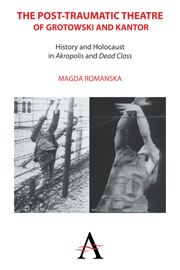 The Post-traumatic Theatre of Grotowski and Kantor
The Post-traumatic Theatre of Grotowski and Kantor from Part I - Our Auschwitz: Grotowski's Akropolis
The ethical and formal relationships between survivors and those who had not undergone such experiences became the basis for the “detailed investigations of the actor-audience relationship.” Grotowski wrote that, in Akropolis, he consciously (and counterintuitively) mixed the actors with the spectators. As Walter Kerr put it: “He has put the audience and the actors together in an extraordinarily close relationship without insisting upon that false intimacy, that overbearing directness of contact, that marks and mars the work, say, of the Living Theatre.” The goal was for the spectators to remain distant, like witnesses, but also to immerse them in the theatrical reality. In an interview, Grotowski said: “In Akropolis the audience represents the living watching the ‘dead’ inmates in the nightmare dreams. Ultimately the audience must give its own answer. Will mankind retrieve its past dreams? Can it survive the greatest brutality of the century? Is there hope?” Or as Flaszen put it:
The action takes place in the entire space, among the viewers. But this time, they are not invited to participate. On the contrary, there is a total lack of contact between the actors and the viewers. They exist in two different, impenetrable worlds: those who are inducted into the final experience and those who aren't, who understand only everyday life – the dead and the living. Physical closeness only enhances psychological distance: the viewers, placed face to face, are ignored. The dead appear in dreams of the living, strange and incomprehensible. And, as in a nightmare, they surround us from all sides.
To save this book to your Kindle, first ensure [email protected] is added to your Approved Personal Document E-mail List under your Personal Document Settings on the Manage Your Content and Devices page of your Amazon account. Then enter the ‘name’ part of your Kindle email address below. Find out more about saving to your Kindle.
Note you can select to save to either the @free.kindle.com or @kindle.com variations. ‘@free.kindle.com’ emails are free but can only be saved to your device when it is connected to wi-fi. ‘@kindle.com’ emails can be delivered even when you are not connected to wi-fi, but note that service fees apply.
Find out more about the Kindle Personal Document Service.
To save content items to your account, please confirm that you agree to abide by our usage policies. If this is the first time you use this feature, you will be asked to authorise Cambridge Core to connect with your account. Find out more about saving content to Dropbox.
To save content items to your account, please confirm that you agree to abide by our usage policies. If this is the first time you use this feature, you will be asked to authorise Cambridge Core to connect with your account. Find out more about saving content to Google Drive.